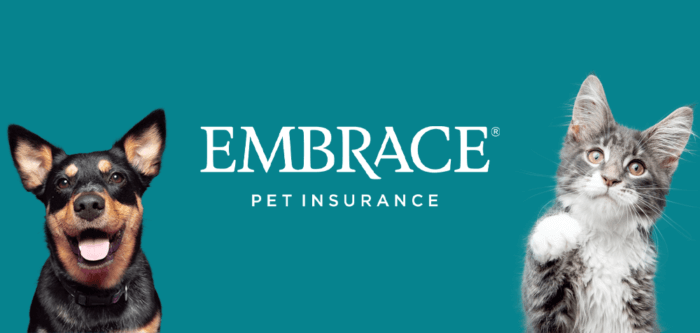Pets have the same chances of getting sick as humans. And contrary to what a lot of people may assume, the veterinary cost of treatments may become a burden for those who don’t make the appropriate plans for it. Veterinary cost is also one major reason some people refuse to take animals as pets – they can come unexpectedly and make a significant impact on anyone’s budget. That’s why it’s important to put a financial safety net in place that you can fall back to when unforeseen circumstances come into play. That safety net is what we refer to as pet insurance. Pet insurance works in a similar way as your own health insurance, except that this time it’s your pet in question. With a best pet insurance plan in place, you can offset the costs of vet bills when they come unexpectedly. Also, it helps you have a peaceful relationship with your pet, knowing that if they ever get sick or injured, you have a good plan in place to help out.
Just like our health insurance, there are a number of pet insurance companies with different offerings and the best pet insurance for you will be the one that best suits your needs, budget, and type of pet. But understanding the ins and outs of pet insurance coverage is hardly straightforward and what about comparing pet insurance to make sure you’re getting the best coverage for the best price? For that reason, we’ve put in the work to come up with the three top pet insurance providers. We’ve also included a detailed guide to help you through the complex process of picking the right pet insurance service for your pet.
3 Best Pet Insurance Companies
- Eusoh – Editor’s Choice – Best Pet Insurance
- Pet Insurer – Runner Up
- Embrace Pet Insurance – Honorable Mention
Insurifind – Compare Pet Insurance Rates Easily
Getting the best possible price for your pet insurance policy is important, but it’s not the only factor to consider when choosing a pet insurance provider. That’s why Insurifind provides an in-depth look at each company’s coverage options, customer service ratings and more. Use their free comparison tool to ensure you’re buying the pet insurance policy that is best for your needs.
How We Chose These 3 Pet Insurance Companies
Our team followed a 360 methodology style to evaluate the large universe of providers in the pet insurance industry to choose our best pet insurance providers. The factors that played the largest role in our selection process were:
- The availability of pet insurance policies that fit budgeting needs. It’s important that a pet insurance company offers coverage that’s dependable and affordable to most pet owners. Each insurance company recommended here is able to provide optimal service while remaining within the affordability range.
- The ease and speed at which claims can be made. For us, the process of insuring, submitting claims and getting reimbursed should be as straightforward as possible, and that makes ease and speed an important factor. You don’t have to go through a long process or wait for a long time before you can lay claim to what’s rightfully yours.
- The excellence of customer service is also an important thing we considered. Looking through an array of reviews and ratings, we were able to deduce the level of customer satisfaction previously received from these recommended companies. With that, we were able to get a good picture of the kind of service each pet insurance company offers.
- Discounts and add-on coverage are as important to us as they are to you! To make our list, insurers needed to offer the flexibility to add coverage as needed and have good deals available.
Reviews of Best Pet Insurance Plan Companies
1. Eusoh – Editor’s Choice for the Best Pet Insurance

Pros:
- Covers more types of treatments than the average pet insurance
- Very transparent pricing structure
- Generous referral bonus
- No pet enrollment age limit
Cons:
- Thirty-day waiting period
Overview
Eusoh is a community-based pet insurer that offers more coverage than standard insurance policies with the option of joining groups and helping to fund each other’s veterinary costs. With Eusoh, you only need to pay for your community’s cost of care instead of a set premium to an insurance company. It provides a transparent structure that cuts off any claims of an insurance company claiming out-sized profits.
What Does Eusoh Coverage Look Like?
Eusoh enrolls all members and their pets in the same regular pet insurance policy with broad coverage including accident and illness coverage, wellness and preventive care, medications, cancer treatments and more. Eusoh does not rely on the traditional insurance notion of a network of providers. Instead, pet parents are free to use the services of any veterinarian and there are no restrictions on the breed or age of pets.
Once you sign up, you join a cost-sharing community of at least 10 members where you can see all of the community’s average expenditures six months prior to your joining. As a member, you’re expected to pay an annual $250 deductible with a maximum of $8,500 in reimbursements every year. For fairness reasons and to prevent potential fraud, you aren’t allowed to submit any expenses for reimbursement for the first 30 days after joining.
What’s Eusoh Pricing Like?
Eusoh’s pricing structure is different than regular pet insurance companies because it’s based on a cost-sharing model rather than traditional premium payments. When you sign up, Eusoh takes a flat $17 monthly fee per pet from you, and that’s the only profit they make through the entire process.
You’ll also be required to deposit $48 to cover the cost of treatments within your community. At the end of every month, you’ll be required to refill the deposit account back up to $48. The monthly contributions to the deposit account will vary from $0 to $48 depending on the vet expenses incurred by other pet parents in your membership community. Discounts on the membership fee are available for households with more than two pets.
Summary
Overall, Eusoh offers a better deal than most standard pet insurance policies. Aside from having a longer waiting period, Eusoh provides its customers with great services and features that work for most pet owners.
Read more about the best offer at Eusoh.com
2. Pet Insurer

Pros:
- Multiple coverage options across many of the best pet insurance companies
- Broad range of price points
- Innovative, robust scoring method
- Price guarantee
Cons:
- Number of options can be a bit bewildering
Overview
Founded by animal lovers who recognized the value and need of insurance coverage for their pet but were thoroughly frustrated trolling through the countless websites of insurance providers, Pet Insurer provides a sophisticated platform to compare pet insurance plans across multiple companies. By simply answering a few questions on a short survey, Pet Insurer will return around 15 quotes from various providers offering different policies – one of which is sure to meet pet parents at any budget level. Of special note is Pet Insurer’s proprietary scoring system which measures the quality of a given pet insurance policy. The score is made up of multiple factors, such as price and product features, and is a useful tool for gauging the quality of one plan against plans of other pet insurance companies.
What Does Pet Insurer Cover?
The best pet insurance companies that work with Pet Insurer offer a huge variety of plans that provide accident and illness coverage, accident only coverage, illness coverage, regular vet visits, wellness programs and more. Depending on the pet insurance plan you choose, hospitalization, emergency care, surgeries, medications, and more can be covered. It all depends on your circumstances and what the needs of your pet are. For those new to pet insurance, the Pet Insurer site has a good deal of useful information available to help you decide which is the best pet insurance for your companion.
What’s Pet Insurer Pricing Like?
Price depends on the pet insurance policy you purchase and what it covers. Generally, dog insurance starts at $15 a month and $9 a month for cats, and can run up to over $100 each month for premium plans that provide unlimited coverage for vet visits as well as generous accident and illness coverage, emergency coverage and wellness plans.
Summary
Pet Insurer users rave about how easy Pet Insurer makes it to purchase quality insurance coverage. Because they only partner with high-quality pet insurance providers you know the insurance policies are sound. And with their helpful scoring system and guarantee that their price is the lowest available online or they will refund the difference, pet owners can confidently make an informed purchase.
3. Embrace Pet Insurance

Pros:
- Discounts up to 25% available
- Wellness and emergency care coverage is available
- Offers a vanishing deductible program
- Accident-only plan is available
Cons:
- No zero-deductible or unlimited benefit options
Overview
Embrace sold its first pet insurance policy in 2006, and has since then offered policies that cover more treatments than a typical insurer provides. They also offer a wider range of coverage options when compared to other pet insurers, as well as an option for emergency coverage only.
What Does Embrace Pet Insurance Cover?
Embrace Pet Insurance offers two types of policies: an accidents only policy (no illness coverage) and an accident and illness policy. Like most services, Embrace includes a two-day waiting period for accident coverage benefits, and a 14-day waiting period for illnesses. There is a 60-day waiting period for orthopedic-related treatments.
Embrace’s accident and illness policy offers “nose to tail coverage” and includes a wide range of treatments and services, like hospitalization, chronic conditions, rehabilitation, emergency care, surgery, behavioral therapy, prescriptions, exam fees, and more. The accident-only policy, on the other hand, is available exclusively for pets over the age of 15. The costs covered include injuries, road traffic accidents, poisoning, cuts, swallowed objects, and prescribed drugs.
What’s Embrace Pet Insurance Pricing Like?
Embrace Pet Insurance begins from $145 each year. With this, you can easily get a customized quote from their site based on your pet’s specifics – age, breed, and the amount of coverage you want. You also get the choice of picking a deductible from $200 to $1,000 for the double accident and illness plan, and an annual deductible of $100 for the accident-only plan. Embrace is recommended for its Healthy Pet Deductible discount; for every year that you don’t file an accident or illness claim to Embrace, your deductible gets reduced by $50.
Summary
Embrace Pet Insurance is a great fit if your pet is young and has a lower chance of getting injured or sick, so you can take advantage of the healthy pet deductible credits.
Learn more at EmbracePetInsurance.com
How Does Pet Insurance Work and What Does it Cover?
Pet insurance helps you cut down on the financial risk of unexpected veterinary costs. With the right pet coverage plan, you can attain peace of mind that you’ll be able to take the best care of your furry or even feathered best pal. Pet insurance works similar to human health insurance with a few differences; one big difference being that you pay vet bills up front and insurance reimburses you for the costs. Like your health insurance, once every month, you are required to pay a premium that continues the coverage. The policy you pick will determine the expenses that are covered, your reimbursement and deductible rate, and annual as well as lifetime payout limits.
Pet health insurance doesn’t require that you get to use an in-network veterinarian. Instead, the majority of plans reimburse the policyholder directly, instead of going through the vet. Generally speaking, to get payment from the insurance company, you have to:
- Pay the vet bill during your visit
- Submit a claim to your insurance company
- Get reimbursed for your covered expenses
To process your claim, insurance companies require you to submit paperwork from your veterinarian to ensure that your claims tally, so ensure that you save all documentation after appointments. A typical reimbursement will happen within 5 to 9 days after submitting your claim.
When it comes to what pet insurance covers, most plans provide substantial coverage for things like general checkups, accident and illness treatments and diagnostics. Pet insurance generally covers:
- Unforeseen injuries/accidents
- Unforeseen illnesses
- Surgeries
- Medication
- Tests/diagnostics
- Emergency exam fees
Insurance policies occasionally cover:
- Alternative therapies
- Hospital boarding
- Nursing
- Acupuncture
- Behavioral modification
- Lost pet advertising and reward
- Hydrotherapy
- Chiropractic
As you can see, insurance for pets covers a wide variety of costs, but no company will cover pre-existing conditions without any questions asked. However, some insurers, like Embrace that we highlighted above, will provide conditional coverage for curable conditions. Check policies carefully before buying for how a specific insurance plan defines a pre-existing condition and what coverage will be provided.
How to Choose the Right Pet Insurance
To pick out the best pet insurance plan for your needs, you need to have a good knowledge of your pet’s medical history and the budget you’re working with. Then, because most pet insurers offer different coverage plans, you should consider the things that matter the most to you, putting the types of illnesses or accidents you want to have covered and the percentage of costs you’ll be able to pay into consideration. After that, it’s time to start obtaining and comparing quotes for different pet insurance policies. It’s wise to get at least 3 or 4 quotes from reputable providers like the insurance companies we recommend. Compare the types of coverage to get an overview of the options in your budget. Most times, the prices and coverage of the plans will vary depending on your location and the particulars of your pets.
When looking into the policy variables, there are a number of things for pet owners to consider. However, the three major aspects to put into consideration are coverage, benefits, and premiums. You need to ensure that you go over the policies, so you’re sure you get reimbursed for the type of coverage you require. If you aren’t sure, ask their customer service team the necessary questions and get all the information you need before proceeding. Here’s a brief explanation of the three major aspects of most insurance plans to consider.
- Coverage: Coverage details the types of ailments a given insurance policy will reimburse for. The most common coverage is for accident and illness concerns, but there are other types to consider as well including wellness plans and specialty coverage that will cover the costs of advertising for a lost pet. Also, be aware that pet insurers will have a waiting period before a new policy goes into effect to protect themselves against fraud. The time period you have to wait varies, but typically is around 14 days.
- Benefits: Benefits refers to the amount a company will pay you for a covered incident or ailment, and it’s determined by the type of insurance plan or policy you’ve purchased.
- Premiums: Premium is the amount you pay each month for the coverage and benefits you receive from your policy. The premium you pay will depend on the coverage and benefits you’re entitled to as detailed in the insurance policy.
Why You Should Get Insurance for Your Pet
Yes, it’s possible that you have doubts about the usefulness of an insurance plan for your beloved pet. If you’re unsure of its worth, you should just consider it as a regular health insurance plan and reflect on how you would deal with an unforeseen bill. Depending on the level of illness or treatment and your location, pet insurance costs will vary but can easily skyrocket into something way above expectations.
For that reason, you should get a pet insurance plan that will help balance the cost of premiums and the chances that you’ll make a claim. Consider the following when you’re thinking about getting pet insurance.
- The age of your pet: Although younger pets typically cost less and are less likely to need medical attention when compared to older pets, that doesn’t mean vet visits won’t be necessary. Young dogs in particular are prone to accidents and emergency costs can put a big dent in anyone’s budget; in fact, costs for emergency surgery can be close to $1,000 or more.
- The type of pet: Dogs and cats are the most commonly insured animals and pet insurance plans with competitive rates aren’t hard to find. Other animals like small mammals, exotic pets like parrots and snakes are tougher because there aren’t many pet insurance companies that offer coverage for exotic pets, and some of them have shorter lifespans. A pet with a short lifespan may not be a good choice in regards to good value. But if you have pets like cats and dogs, then you should strongly consider pet insurance.
- The risk posed by your pet: While the type of pet you own is a valid factor, you should also consider how susceptible your pet is to illnesses, injuries, and similar conditions. For instance, larger dogs have a higher chance of developing joint problems and some breeds are prone to developing specific health conditions.
- The possibility of the self-insurance alternative: Self-insurance includes budgeting and saving on your own to ensure that you’re equipped to take good care of your pet. If you aren’t a self-disciplined and focused pet owner, this may not be the right choice for you because you’ll have to cover a lot of ongoing expenses on your own.
Can I Use My Own Vet With Pet Insurance?
As we mentioned earlier, pet insurance plans don’t require that you get an in-network vet to benefit from your coverage. Instead, the majority of pet insurance companies in the U.S. reimburse the policyholder directly, instead of going through the vet like human health insurance does. So, pet owners can use the vet of their choice, irrespective of the insurance policy you opt for.
You may find some pet insurance companies that provide an online platform for their users that allows a couple of services, which may include access to veterinarians online. You aren’t obliged to use the veterinarians provided, as it’s only a means to ensure that you get maximum services from their company.
Frequently Asked Questions
1. When should I get pet insurance?
The best time to get pet insurance is when your pet is young. This is because younger pets hold more value in insurance as they have a higher chance of living longer. Enrolling your pet at a younger age also means you’re likely to pay lower premiums, and establishing fresh coverage is more expensive and takes a longer time than continuing on an existing plan – so better to start at a young age than when your pet is older.
2. What are the types of pet insurance coverage?
A good number of insurance cover types exist, but there are four major types:
- Lifetime: As indicated by its name, lifetime insurance coverage is the most all-inclusive type of insurance available. With a lifetime policy, you’ll have renewable coverage for as long as your pet lives – irrespective of an existing condition or age of the pet. Of course as your pet ages premiums are likely to increase, but should still be less than a new policy or the out-of-pocket costs should your pet be denied coverage due to age or pre-existing conditions.
- Annual (or time-limited): Annual coverage is a term policy that is renewed on a yearly basis, unlike lifetime policies that simply continue on every year. So, each year you have the option of switching to a cheaper policy if you wish. It characteristically costs less than the life coverage. Be careful with this option, though, because chronic issues may not be covered when you renew a policy, and many pet insurance companies may not offer this type of insurance coverage as the pet grows older.
- Accident only: This is the simplest form of coverage available, as it’s cheap and basic. It covers any type of accident that may happen to your pet. However, it doesn’t cover treatments for illnesses or other ailments such as joint issues.
- Maximum benefit: Sometimes referred to as “per condition” coverage, this provides you with a specific sum, or maximum amount, to treat any illness or injury. Once the maximum dollar amount is reached, however, treatments will no longer be covered and the ailment may revert to being a pre-existing condition.
3. Does my pet insurance automatically renew?
Presuming that you are up-to-date with payments, the majority of pet insurance plans will renew automatically. Costs, however, may not remain the same and are likely to increase.
Most insurers require a 28 days advance notice if you do not wish to renew your insurance policy. Some others take the route of sending you a renewal message at the end of the year. So, if you wish to renew, you’ll have to respond to that, or no form of action will be taken.
4. How do pet insurers know about pre-existing conditions?
A pre-existing condition is any type of ailment or illness that your pet developed, showed signs of, was diagnosed with, or was treated for before the waiting period ended with your pet health insurance policy. The norm is that most insurers won’t make provisions to cover costs that directly relate to those pre-existing conditions. Your policy will clarify that diagnoses, treatments, and symptoms of a condition listed in your pet’s medical record before they were insured will indicate a pre-existing condition, and you will not be entitled to receive reimbursement for care relating to it.
While some breeds of animals have a higher tendency of developing certain illnesses, they aren’t automatically categorized as pre-existing conditions. But if they do develop the problem before or during the waiting period, then they’re fully pre-existing conditions. That’s another reason it’s advisable to enroll pets at a younger age when conditions may not have shown up, rather than waiting for when they start developing the symptoms before getting them insured. If the latter happens, the condition may not be covered in your policy.
5. Is pet health insurance worth it if my pet has a pre-existing condition?
Pet health insurance is almost always going to be worth it, and you shouldn’t wait until you need insurance before you get it. Instead, you should get a policy as soon as you own a pet. Even with a pre-existing condition, pet insurance is still worth it because your pet can develop other problems which may be a huge responsibility if you have to handle costs for that alongside a pre-existing condition.
6. How do I choose a deductible?
You’re expected to pay an initial deductible by yourself before your insurance company will payout any form of benefit. Deductibles can be as low as $50 or as high as $1,000. You should remember that a higher deductible implies lower annual premiums. So, setting the deductible as high as you can will probably reduce your monthly payments. Just be sure you’re able to budget enough to cover the deductible as well as the premiums.
7. Do pet insurance plans offer discounts?
Yes. Plan discounts are a common feature of most insurance companies. One type of discount is when you insure multiple pets with the same company. They offer you a budget-friendly quote that will be convenient for you. Also, discounts usually apply to members of the military, veterans, and those who work in jobs relating to animal care.
Conclusion
At this point, we understand how pet insurance is important to pet parents because you’ll never be able to predict the illness, injury, or condition that your beloved pet is going to develop. For a lot of pet owners, taking care of a pet is similar to caring for a child, therefore the important need to mitigate the financial risk of astronomically high vet bills. You definitely don’t want to lose your pet to permanent maiming or death because you weren’t able to cover the cost of veterinary needs or an important surgery.
There are a lot of insurance companies that offer you different types of policies for your pets, and it’s left to you to decide which one best fits into your goal, budget, and need of your pet. Picking the pet insurance service that will be best for your companion isn’t the most straightforward task, especially considering the complexity of coverage and payment options, as well as other important decisions that need to be made. For that reason, we’ve done the research and presented the best pet insurance companies to make the decision-making process of buying the best pet insurance policy easier. From our list above, you’ll be able to find at least one company that fits your pet insurance requirements. We’re confident that each pet insurance company we’ve highlighted above is trusted, dependable, and will deliver.





































